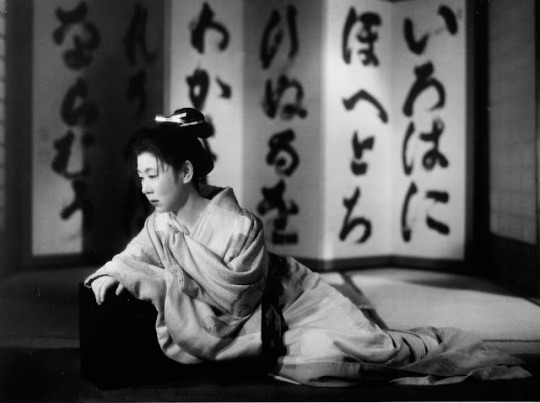#Tsuji Shindo
Explore tagged Tumblr posts
Text

Tsuji, Shindo 辻晉堂 1910 - 1981 - About the Distance between the Eyes and Nose, 1965. Stoneware, 48.0×46.0×47.0 .
7 notes
·
View notes
Photo

Kinuyo Tanaka in The Life of Oharu (Kenji Mizoguchi, 1952)
Cast: Kinuyo Tanaka, Tsukie Matsuura, Ichiro Sugai, Toshiro Mifune, Toshiaki Konoe, Kiyoko Tsuji, Hisako Yamane, Jukichi Uno, Eitaro Shindo, Akira Oizumi, Kyoko Kusajima, Masao Shimizu, Daisuke Kato. Screenplay: Kenji Mizoguchi, Yoshikata Yoda, based on a novel by Saikaku Ihara. Cinematography: Yoshimi Hirano. Production design: Hiroshi Mizutani. Film editing: Toshio Goto. Music: Ichiro Saito.
Oharu (Kinuyo Tanaka) is by turns a lover, a concubine, a courtesan, a servant, a wife, a prostitute, and a nun, which in the 17th-century Japan of Kenji Mizoguchi's film is almost everything a woman could possibly be. But Tanaka's great performance individualizes Ohara, keeping her from just being a representative figure, a stand-in for Woman. Over the course of the film, Oharu suffers almost every indignity that could be inflicted on her: At the court in Kyoto where she is a lady in waiting, she falls in love with a page, Katsunosuke (Toshiro Mifune), but when their affair is discovered, she and her parents are expelled and he is beheaded. One day a courtier for a powerful feudal lord comes to the village where they are exiled: The lord is in need of an heir, and his wife is barren. Oharu fits his rather exacting specifications to the letter, so she is brought to his palace where she bears him a son, but she's not allowed to nurse the child and is expelled from the household by his jealous wife. She goes to work as a courtesan to pay off the debts incurred by her greedy father (Ichiro Sugai), takes a job as maid to a woman who suspects her of sleeping with her husband, marries a man who is killed by robbers, and becomes a Buddhist nun but is expelled from the temple for supposedly seducing a man who was actually trying to rape her. Years pass and she loses her beauty and now walks the streets to earn money to survive, but she is subjected to scorn and mockery as a "goblin cat" by a man leading a group of young pilgrims. Hope dawns when she is summoned to meet her son, who has succeeded his father as lord, but it turns out that the officials in the court really want to cover up the fact that their lord's mother has been a prostitute, so she runs away after only a brief and distant glimpse of him. At the end she wanders the streets as an itinerant nun receiving alms in exchange for prayers -- her prostitution is now spiritual rather than physical. It's easy to take a synopsis like this and dismiss the story as "lachrymose as a soap opera," and "a reverse Horatio Alger adventure," as a particularly obtuse New York Times review did when The Life of Oharu was first released in the United States in 1964. It is neither of those things, of course. Even the Times reviewer was struck by Tanaka's performance, Mizoguchi's direction, and Yoshimi Hirano's cinematography, without understanding how or why these elevate the story into art. The story comes from a 17th-century novel by Saikaku Ihara, The Life of an Amorous Woman, a work far more erotic and picaresque than the melancholy screenplay Mizoguchi and co-screenwriter Yoshikata Yoda derived from it. The Life of Oharu is unremittingly grim -- it put me in mind of the novels of Thomas Hardy, whose characters suffer more than seems absolutely necessary for the author to make his point about the workings of fate. But the film is not about suffering; it's about strength, and women's strength in particular.
10 notes
·
View notes
Text
who/what i write for!

i write female, male and gender neutral reader. i prefer writing female but i can still write male and gn if requested!
i will not write the following: scat, piss kink, feet kink


avatar, the last airbender
sokka, jet, zuko, azula, katara, aang
avatar, legend of korra
korra, mako, bolin, asami

haikyuu!!
karasuno tanaka, sugawara, kageyama, hinata, tsukishima, yamaguchi, nishinoya, daichi, yachi, kiyoko, ukai
nekoma kuroo, kenma, lev
aoba johsai oikawa, iwaizumi, hanamaki, matsukawa, kyotani
date tech aone, futakuchi, koganegawa
fukurodani bokuto, akaashi, konoha
shiratorizawa ushijima, tendou, semi, goshiki, shirabu
inarizaki kita, aran, atsumu, osamu, suna
other sakusa, terushima, daisho

duty after school
kwon ii-ha, wang tae-man, jo jang-soo, kim chi-yeol, do soo-chul, im woo-taek, woo hee-rak, yeon bo-ra, lee na-ra, lee choon-ho

assassination classroom
karma, isogai, sugino, chiba, terasaka, nakamura, maehara, itona, asano, sakakibara

maze runner
minho, thomas, newt, gally

ouran highschool host club
tamaki, kyoya, mori, kaoru, hikaru, haruhi

the disastrous life of saiki k
saiki, kuboyasu, kaidou, teruhashi, saiko, mikoto

across the spider-verse/into the spider-verse
miguel, miles, hobie, peter (mcu)

jujustu kaisen
gojo, geto, nanami, yuta, itadori, megumi, shoko, nobara, choso, toji

all of us are dead
nam on-jo, lee cheong-san, choi nam-ra, lee su-hyeok, han gyeong-su, oh joon-yeong, jang wu-jin, yoon gwi-nam

avatar + avatar, the way of water
neteyam, lo'ak, aonung, jake

boku no hero academia
class 1-a iida, ojirou, kaminari, kirishima, shoji, jirou, yaoyorozu, todoroki, sero, bakugou, midoriya
class 1-b kuroiro, awase, kendo, monoma, tetsutetsu
pro heroes best jeanist, kamui woods, eraserhead, present mic, edgeshot, hawks
other shinsou, hatsume, tamaki, nejire, mirio, shindo

attack on titan
eren, mikasa, armin, hange, levi, erwin, sasha, jean, connie, miche, porco, bertholdt, reiner, annie, nicolo, ymir

one piece (live action)
luffy, zoro, nami, usopp, buggy, sanji

lookism
daniel park, vasco, zack lee, jay hong, jace park, vin jin, eli jang, warren chae, jake kim, eugene, yuseong, dg/james lee, gun park, goo kim, johan seong, samuel seo, taejin cheon, jihan kwak, jichang kwak, gitae kim, xiaolung, seongji yuk

high & low
sword masaki amamiya, hiroto amamiya, cobra, yamato, rocky, koo, murayama, takeshi, p, smoky, hyuga, jesse
the worst fujio, tsukasa, nakagoshi, yasushi, todoroki, shibaman, tsuji, sachio, odajima, shidaken, sawamura shoji, rao, kamui, binzo, yamaguchi, amagai, ryo, sameoka shoji, reiji

harry potter
harry potter, ron weasley, hermione granger, dean thomas, fred weasley, george weasley, draco malfoy, blaise zabini, mattheo riddle, tom riddle, lorenzo berkshire, theodore nott, cedric diggory, victor krum
5 notes
·
View notes
Photo

辻晉堂著作集 泥古庵雑記 三彩社 装丁=熊谷博人
8 notes
·
View notes
Photo

#FoodWarsTheFourthPlate #食戟のソーマ #FoodWars #ShokugekiNoSōma #SōmaOfTheShokugeki #ShokugekiNoSoumaShinNoSara #KingDevinJoseph #Weaboo #WéäBóo #キングデビンジョセフ #おたく #Otaku #オタク #GotoJobin #後藤Jobin #デヴィンジョセフ王 #Weeb #WeebDar #王デヴィンジョセフ 1. Episode 3 WEB Limited Next Notice Screenplay: Yaskawa Shogo Tsuji-e-Conte: Hiroyuki Okuno Director: Kazuya Miura Director: Tomoya Nokai, Tsukasa Sakurai, Nobuharu Ishido Director: Tomoyuki Shimotani, Mai Matsuura, Masakazu Yamazaki "Autumn Selection" This Match, The 2nd Match, Finally Decided! The result of the concern is ...!? In the third game when the day changed, The winner's candidate, Akira Hayama and Erina's aide Shindo Sayako clashed! Which is the ultimate "hamburger" showdown? On the other hand, there is some disturbing air between Takumi and Mimasaka, who will play in the fourth game. 2. Episode 3 WEB-limited next time notice ■ Screenplay: Yasukawa Shogo ■ Storyboard: Hiroyuki Okuno ■ Production: Kazuya Miura Drawing director: Chika Noumi, Tsujii, Tsukasa Nobuharu Ishido ■ Director: Tomoyuki Shimotani, Mai Matsuura, Masakazu Yamazaki "Autumn selection" final game, the second game is finally settled! What is the result you care about?!? In the third game where the day has changed, the top candidate, Akira Hayama and Erina's close friend, Satoko Nito clash! Which is the ultimate hamburger showdown? On the other hand, there is a somewhat disturbing atmosphere between Takumi and Mimasaka who will compete in the fourth game ...? https://www.instagram.com/p/B5_paDbHVcc/?igshid=1rxkrvmh38kkh
#foodwarsthefourthplate#食戟のソーマ#foodwars#shokugekinosōma#sōmaoftheshokugeki#shokugekinosoumashinnosara#kingdevinjoseph#weaboo#wéäbóo#キングデビンジョセフ#おたく#otaku#オタク#gotojobin#後藤jobin#デヴィンジョセフ王#weeb#weebdar#王デヴィンジョセフ
0 notes
Text
Exome sequencing reveals a novel missense mutation in the KIAA0196 gene in a Japanese patient with SPG8.
PubMed: Related Articles Exome sequencing reveals a novel missense mutation in the KIAA0196 gene in a Japanese patient with SPG8. Clin Neurol Neurosurg. 2016 May;144:36-8 Authors: Ichinose Y, Koh K, Fukumoto M, Yamashiro N, Kobayashi F, Miwa M, Nagasaka T, Shindo K, Ishiura H, Tsuji S, Takiyama DY Abstract Exome sequencing revealed a novel missense mutation (c.2152G>A, p.E713K) in the KIAA0196 gene in a Japanese patient with SPG8. To date, only 10 mutations in the KIAA0196 gene have been reported in the world. We describe the clinical and genetic findings in our patient with SPG8, which is a rare dominant hereditary spastic paraplegia. Notably, our patient showed mild upper limb ataxia, which is a relatively atypical symptom of SPG8. Thus, our patient showed a wide clinical spectrum of SPG8. PMID: 26967522 [PubMed - indexed for MEDLINE] http://dlvr.it/N3FcR3
0 notes
Text

Tsuji Shindō (1910-1981) - Female Nude .
5 notes
·
View notes
Photo

Kyoko Kagawa in Sansho the Bailiff (Kenji Mizoguchi, 1954)
Cast: Kinuyo Tanaka, Yoshiaki Haniyagi, Kyoko Kagawa, Eitaro Shindo, Akitake Kono, Masao Shimizu, Ken Mitsuda. Screenplay: Fuji Yahiro, Yoshikata Yoda, based on a story by Ogai Mori. Cinematography: Kazuo Miyagawa. Production design: Hisakazu Tsuji. Film editing: Mitsuzo Miyata. Music: Fumio Hayasaka, Kinshichi Kodera, Tamekichi Mochizuki.
It's rare to see a film whose title character is the villain -- unless you count monster movies like the many versions of Dracula -- but Sansho (Eitaro Shindo) is decidedly that, the slave-driving administrator of a medieval Japanese manor. (It's as if Uncle Tom's Cabin had been called Simon Legree.) But in fact, Sansho serves as a catalyst for the story that centers on an aristocratic family. The father displeases his feudal lord by being too merciful to the people he governs, so he's banished to a distant province while his wife, Tamaki (Kinuyo Tanaka), and their children, Zushio and Anju, remain behind with her brother until the children are old enough to make the dangerous cross-country journey. But when they set out, they are betrayed and sold into slavery. Tamaki is forced into prostitution and separated from the children, who grow up as slaves on the estate administered by Sansho. One day, Anju (Kyoko Kagawa) hears a new slave, brought from the island of Sado, singing a song about a woman who mourns the loss of her children named Zushio and Anju, and learns that her mother is still alive. Meanwhile, Zushio (Yoshiaki Hanayagi) has decided that the best way to survive in slavery is to go along with Sansho's demands, which include punishing an elderly slave by branding him on the forehead. Anju is appalled by what her brother has become, because he has turned against the principles of mercy and human equality that their father taught them, but when the opportunity to escape presents itself, she persuades him to do so. Staying behind, and facing the wrath of Sansho, she drowns herself. Eventually, Zushio wreaks revenge on Sansho and liberates the slaves, then goes in search of his mother. This reworking of an ancient fable is one of the most miraculous of films, an exquisitely photographed (by Kazuo Miyagawa), designed (by Hisakazu Tsuji), and acted work, radiating Mizoguchi's deep human sympathy. Tanaka, who starred in Ugetsu (1953) and The Life of Oharu (1952), the other two films usually ranked alongside Sansho the Bailiff as Mizoguchi's greatest works, has a smaller role than in the others, but her final scene in this film is one of the most heart-breaking performances in all movies.
4 notes
·
View notes
Photo

Kyoko Kagawa and Kazuo Hasegawa in A Story From Chikamatsu (Kenji Mizoguchi, 1954) Cast: Kazuo Hasegawa, Kyoko Kagawa, Eitaro Shindo, Eitaro Ozawa, Yoko Minamida. Screenplay: Matsutaro Kawaguchi, Yoshikata Yoda, based on a play by Chikamatsu Monzaemon. Cinematography: Kazuo Miyagawa. Production design: Hisakaza Tsuji. Film editing: Kanji Suganuma. Music: Fumio Hayasaka, Tamezo Mochizuki. Kenji Mizoguchi's A Story From Chikamatsu, which has also been released under the built-in-spoiler title The Crucified Lovers, is based on Chikamatsu Monzaemon's 18th-century play The Legend of the Grand Scroll-Maker. It's a romantic drama about doomed lovers that Mizoguchi and screenwriters Matsutaro Kawaguchi and Yoshikata Yoda have expanded into a fable about greed, injustice, and the subjugation of women. The lovers don't even start out as lovers, but circumstances force them together. Mohei (Kazuo Hasegawa) is a somewhat overworked apprentice scroll-maker who is thrown together with his master's wife, Osan (Kyoko Kagawa), almost by accident. The master, Ishun (Eitaro Shindo), is a miser and a philanderer, and the circumstances that initially put Mohei and Osan together are almost the stuff of farce: Osan knows that Ishun has been harassing the pretty maid Otama (Yoko MInamida), trying to persuade her to become his mistress, so Osan hides in the young woman's room one night to try to catch her husband in the act. Instead, Mohei goes to Otama's room and is discovered there with Osan. When Ishun finds out he accuses her of adultery, which as we've been shown earlier in the film is a crime punishable by crucifixion. In addition to this crime, Mohei has also been accused of forgery: Ishun had refused to give Osan's brother a loan, so Mohei agreed to help Osan by using Ishun's seal on a receipt, having been assured that the money would be repaid quickly. When confronted with the forgery, Otama intervenes on behalf of Mohei (whom she secretly loves) and says that she asked for the money. The upshot of all this complex of subterfuges, ultimately caused by Ishun's greed and lechery, is that both Osan and Mohei are forced to flee Ishun's household. They determine that suicide would be more honorable than crucifixion, but when they discover that they are in love with each other, they decide that life in hiding would be preferable to death. Things do not go well, of course, but in the end Ishun gets his comeuppance too. There is perhaps a little too much plot and the outcome is foreseeable, but Mizoguchi's mastery of atmosphere, aided by Kazuo Miyagawa's cinematography, lifts the film high above the melodrama. It's at times a strikingly claustrophobic film, whose boxlike interiors sometimes suggest the grids of Mondrian paintings, underscoring the entrapment not only of the lovers but also of those victims of their own avarice, indifference, or subservience who would punish them. When we're not inside, we're on crowded streets, and even when the lovers escape into the countryside, they're adrift on a fog-shrouded lake or framed by the stalks of a bamboo forest, hinting at prison bars. For some reason, perhaps the overcomplexity of the narrative, A Story From Chikamatsu doesn't hold the honored place in the Mizoguchi canon of Ugetsu (1953), The Life of Oharu (1952), or Sansho the Bailiff (1954), but it's still the work of a master filmmaker.
1 note
·
View note



